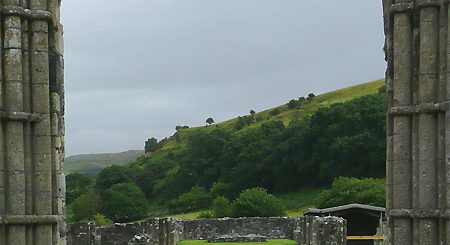St Michaels Parish Church, Ashton-under-Lyne
St Michaels Parish Church is thought to have been founded by Sir John Assheton (died 1428), Member of Parliament and soldier. According to ‘Lancashire Legends’ (1873) by John Harland & T T Wilkinson, Sir John assigned ‘the forms or benches to his tenants: the names for whose uses they are appointed are all females ….Eighteen forms or benches are mentioned for the occupation of one hundred wives and widows, who are named, besides their daughters and servant wenches. Their husbands had not this privilege, being forced to stand or kneel in the aisles, as the service required….At whatever period the church was built, the steeple must either have been erected afterwards, or have undergone a considerable repair in the time of the last Sir Thomas Assheton; for upon the south side are the arms of Ashton impaling Stayley.
 ‘A History of the County of Lancaster: Volume 4’ (1911), tell sus that ‘The church of ST. MICHAEL is at the present day of greater historical than architectural interest. The site is ancient; the church stands at the east end of the town in what was formerly a picturesque situation on rising ground on the north side of the River Tame, and consists of chancel with north vestry, nave with north and south aisles, south porch, and west tower. The present church is entirely modern, but is the direct descendant of a building which appears to have been erected at the beginning of the 15th century (c. 1413), and which was repaired and enlarged about a hundred years later, in the lifetime of Sir Thomas Ashton (died 1514), when a new tower was built. In January 1791 this tower was struck by lightning and great damage was done, necessitating a general repair of the structure in the following year. In 1817 the tower was taken down and a new one erected (1818), and soon after the whole of the north side of the church was rebuilt as at present. Whilst the work was in progress (March 1821) a fire occurred, doing much damage to the original building, which was only partially repaired, the south side continuing in a more or less ruinous state till 1840, when a general rebuilding began, and in the course of a few years the whole fabric underwent a complete restoration and reconstruction, assuming its present aspect (1840–4). The work is of a very elaborate description, with rich ornamentation in wood and plaster, and is a good specimen of the florid Gothic of the period. The east end of the chancel was rebuilt in 1883, and three years later the tower, which was in a dangerous state, was pulled down and a new one built (1886–8). The new tower, the total height of which is 139 ft. 6 in., is 19 ft. higher than the former one, and 3 ft. longer from east to west.
‘A History of the County of Lancaster: Volume 4’ (1911), tell sus that ‘The church of ST. MICHAEL is at the present day of greater historical than architectural interest. The site is ancient; the church stands at the east end of the town in what was formerly a picturesque situation on rising ground on the north side of the River Tame, and consists of chancel with north vestry, nave with north and south aisles, south porch, and west tower. The present church is entirely modern, but is the direct descendant of a building which appears to have been erected at the beginning of the 15th century (c. 1413), and which was repaired and enlarged about a hundred years later, in the lifetime of Sir Thomas Ashton (died 1514), when a new tower was built. In January 1791 this tower was struck by lightning and great damage was done, necessitating a general repair of the structure in the following year. In 1817 the tower was taken down and a new one erected (1818), and soon after the whole of the north side of the church was rebuilt as at present. Whilst the work was in progress (March 1821) a fire occurred, doing much damage to the original building, which was only partially repaired, the south side continuing in a more or less ruinous state till 1840, when a general rebuilding began, and in the course of a few years the whole fabric underwent a complete restoration and reconstruction, assuming its present aspect (1840–4). The work is of a very elaborate description, with rich ornamentation in wood and plaster, and is a good specimen of the florid Gothic of the period. The east end of the chancel was rebuilt in 1883, and three years later the tower, which was in a dangerous state, was pulled down and a new one built (1886–8). The new tower, the total height of which is 139 ft. 6 in., is 19 ft. higher than the former one, and 3 ft. longer from east to west.
There are two traditions associated with St Michaels. ‘Workmen were one day amusing themselves at cards, a female unexpectedly presented herself. She asked them to turn up an ace, promising, in case of compliance, that she would build several yards of the steeple; upon which they fortunately turned up the ace of spades. This tale may owe its origin to the following circumstances:—Upon the marriage of Sir Thomas Assheton with the daughter of Ralph Stayley, a considerable accumulation of property was the consequence. This might induce him to repair the church, and perform sundry other acts of charity and beneficence. Whilst the work was going on, Lady Elizabeth Assheton, it is not improbable, surprised the builders at their pastime; and giving a broad hint that a part of her money was being employed in the erection, might desire that her arms should be fixed in the steeple, impaled with those of her husband. The shape of an escutcheon, having a considerable resemblance to a spade-ace, in all likelihood was the origin of the fable.’ [‘Lancashire Legends’ (1873)].
According to Thomas Barritt (Born 1743 –Died 1820) a Manchester born antiquary, “They have long had a tradition at Ashton-under-Lyne, that in the chancel of the church, the famous General Fairfax lies buried. How this came about I am at a loss to account for, unless done through privacy, to preserve his corpse from the ill-usage of his enemies, and that it was thus secreted through the means of Colonel Dukinfield*, who served in the same cause with Fairfax in the Parliamentary army. Dukinfield Hall lies very near Ashton.”
I assume that Barritt is referring to ‘Black Tom’, General Thomas Fairfax, 3rd Lord Fairfax of Cameron (Born 17 January 1612 – Died 12 November 1671), Parliamentary Commander-in-Chief during the English Civil War and victor of the Battle of Naseby. He resigned in 1650 rather than lead an invasion of Scotland and aided the restoration of King Charles II by neutralising Parliamentary forces in the North of England buying time for General George Monck. General Fairfax died in Nunappleton, and is buried at Bilbrough, Yorkshire.
*Lieutenant Colonel Robert Duckenfield (Born 1619 – Died 1689)

















Recent Comments